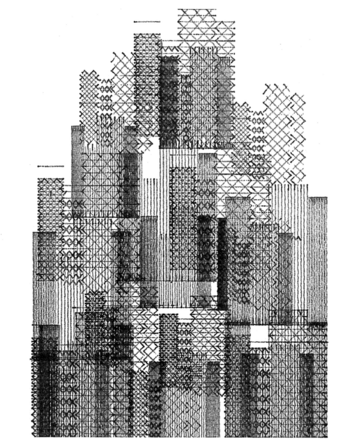Computer art
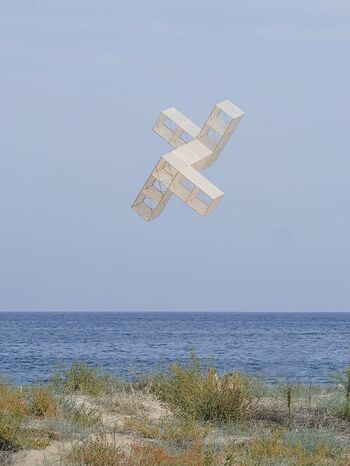
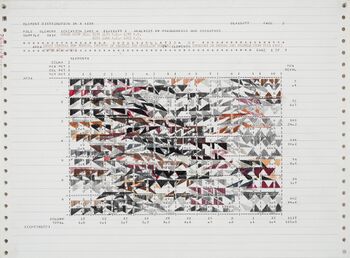
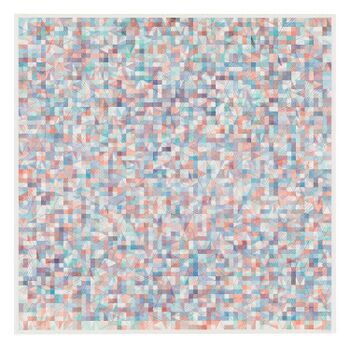
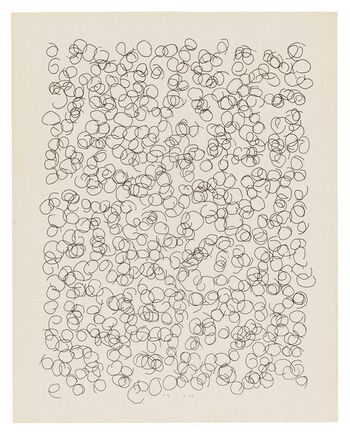
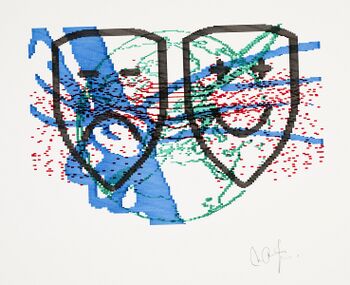
'Computer art' is the generation of aesthetic objects with the aid of software on a digital computer. Its history started in 1965. Three exhibitions took place that year, which are acknowledged as first public presentations of digital art: Georg Nees at the Studiengalerie of the University of Stuttgart (5-19 February 1965); A. Michael Noll and Bela Julesz at Howard Wise Gallery, New York (6-24 April 1965); Frieder Nake and Georg Nees at Galerie Wendelin Niedlich, Stuttgart (5-26 November 1965)... The picture changes slightly, when we closely look at the time when these researcher-artists started their experiments in algorithmic art: Noll in 1962, Nake in 1963, Nees in 1964. All these dates refer to "digital" art and computers. Ben F. Laposky had started to work with analogue equipment in 1952. Herbert W. Franke followed in Austria in 1959, and Kurd Alsleben in Hamburg around 1960."
– Frieder Nake
Artists, writers, events[edit]
- José Luis Alexanco
- Kurd Alsleben
- Ars intermedia
- Radu Bagdasar
- Colette Bangert
- Manuel Barbadillo
- Horst Bartnig
- Juraj Bartusz
- Otto Beckmann
- Max Bense
- Vladimir Bonačić
- Martijn van Boven
- Ileana Bratu
- Zdeňka Čechová
- Harold Cohen
- Compos 68
- Computer and Art
- Computer Art in ČSSR and in the World
- Computer grafik
- Computer Graphic
- Computer Graphics Art (Prague, 1982)
- Computer Graphics in Fine Arts
- Computer Technique Group
- Computerkunst - On the Eve of Tomorrow
- Computers and Automation
- Waldemar Cordeiro
- Charles Csuri
- Cybernetic Serendipity
- Stanisław Dróżdż
- Sherban Epuré
- Peter Foldes
- Helmar Frank
- Herbert W. Franke
- Roland K. Fuchshuber
- Aldo Giorgini
- Karl Otto Götz
- John Halas
- Desmond Paul Henry
- Grace C. Hertlein
- Jiří Hůla
- Ideas Before Their Time
- Mihai Jalobeanu
- Jozef Jankovič
- Charlotte Johannesson
- Béla Julesz
- Hiroshi Kawano
- Keiko Kimoto
- Miroslav Klivar
- Ken Knowlton
- Zenon Kulpa
- Ben F. Laposky
- Ruth Leavitt
- Auro Lecci
- Radomír Leszczynski
- Dominic Lopes
- Aaron Marcus
- Solomon Marcus
- Viktor Ernest Maşek
- Catherine Mason
- Florin Maxa
- Leslie Mezei
- Tomislav Mikulić
- Petar Milojević
- Manfred Mohr
- Abraham Moles
- Vera Molnár
- Ivan Moscovich
- Motif Editions
- Mihai Nadin
- Frieder Nake
- Georg Nees
- New Tendencies
- A. Michael Noll
- Jan Pamuła
- Cord Passow
- Alexandru Patatics
- Sergej Pavlin
- Rosen Petkov
- SCAS
- Programmierter Zufall - Computergrafik
- Vladan Radovanović
- Zoran Radović
- Sonya Rapoport
- Lillian F. Schwartz
- Martin Šperka
- Alan Sutcliffe
- Zdeněk Sýkora
- Yasunao Tone
- Jiří Valoch
- Roman Verostko
- Miguel Ángel Vidal
- Visions of the Present
- Tamás Waliczky
- Peter Weibel
- Teresa Wennberg
- Ryszard Winiarski
- XCoAx
- José María Yturralde
- Gerard Zieliński
- Vilko Žiljak
- Stanislav Zippe
Magazines[edit]
- Bit International: teorija informacija i nova estetika, 9 numbers (7 issues), ed. Božo Bek, Zagreb: Galerije Grada Zagreba, 1968-1972. (multiple languages)
- Leonardo, ed. Frank Malina (later Roger F. Malina), Paris (later San Francisco), 1968–present. Website.
- PAGE, London: Computer Arts Society, 1969-1985 & 2004-2011.
- Creative Computing, ed. David H. Ahl, Morristown, NJ, Nov 1974-Dec 1985. WP.
- Computer Graphics and Art, 12 issues, ed. Grace C. Hertlein, Chico, CA: Berkeley Enterprises, Feb 1976-Nov 1978.
Group exhibition catalogues[edit]
- Arte programmata: arte cinetica, opere moltiplicate, opera aperta [Programmed Art: Kinetic Art, Multiplied Works, Open Works], Milan: Galleria Vittorio Emanuele, 1962, 32 pp. Text by Umberto Eco. Works by Bruno Munari, Enzo Mari, Gruppo T, Gruppo N, Getulio Alviani, GRAV, et al. Organised by Bruno Munari and Giorgio Soavi; sponsored by Olivetti. Exh. held in Milan, May 1962; Piazza S. Marco, Venice, Jul-Aug 1962; Genova, 1962; Piazza Barberini, Rome, Oct 1962; Galleria La Cavana, Trieste, 1962; Tokyo, 1962; Goppinger Galerie, Düsseldorf, 1963; Royal College of Art, London, Jul 1964; Loeb Student Center, New York, 1964; and circulated across other venues in the US by the Smithsonian Institution. Video documentation (10 min). [4] (Italian),(French),(English)
- Herstellung von zeichnerischen Darstellungen, Tonfolgen und Texten mit elektronischen Rechenanlagen. Programm-Information PI-21, Darmstadt: Deutsches Rechenzentrum Darmstadt, Apr 1966, 51 pp. Exh. held at the Deutsche Rechenzentrum, Darmstadt, 15 Jan-15 Feb 1966. [5] (German)
- Computer Graphics, ed. Jiří Valoch, Brno: Dům umění města Brna, 1968, 16 pp. Exh. held at the House of Arts, Brno, 4 Feb-3 Mar 1968; Oblastní Galerie Vysočiny, Jihlava, Mar 1968; Oblastní galerie výtvarného umění, Zlín, Apr 1968. (Czech)
- Cybernetic Serendipidity. The Computer and the Arts: a Studio International Special Issue, ed. Jasia Reichardt, London: Studio International, Jul 1968; 2nd ed., rev., Sep 1968, 103 pp; repr., New York: Praeger, 1969, 101 pp; repr., London: Studio International Foundation, 2018, 101 pp. Exh. catalogue. Features a cover designed by Franciszka Themerson; an introduction by Jasia Reichardt; an overview of cybernetics and its founder, Norbert Wiener; separate sections dedicated to the connections between the computer and music, dance, poetry, painting, film, architecture, and graphics; a glossary; and a bibliography.
- The Magazine of the Institute of Contemporary Arts 5: "Cybernetic Serendipidity", ed. Jasia Reichardt, London: Institute of Contemporary Arts, Aug 1968, 38 pp. With texts by Martin Gardner, Pierre Barbaud, and Charles Csuri.
- The Magazine of the Institute of Contemporary Arts 6: "Cybernetic Serendipidity", ed. Jasia Reichardt, London: Institute of Contemporary Arts, Sep 1968, 38 pp. With texts by Daphne Oram, Max Bense, Petar Milojevic, and Nam June Paik. [6]
- Event One, London: Computer Arts Society, 1969, [22] pp. The first exhibition from the newly-formed Computer Arts Society; held at Royal College of Art, London, 29-30 Mar 1969. Publisher.
- Generación automática de formas plásticas. Vol. 2, Formas computables, ed. Ernesto García Camarero, Madrid: Centro de Cálculo de la Universidad de Madrid, 1969, [8]+[16] pp. Exh. held as the closing session of the seminars Automatic Generation of Plastic Forms for the 1968-69 academic year, at the Centro de Cálculo of the University of Madrid, from 25 June to 12 July 1969. [7] (Spanish)
- Computer-Kunst: On the Eve of Tomorrow, ed. Käthe Schröder, Hannover: Clarissa -Contemporary-Art and G.-W.-Leibniz-Gesellschaft, 1969, [44] pp. Exh. held at Kubus Hannover, 19 Oct-12 Nov 1969. [8] (German)
- Tendencije 4 / Tendencies 4: Zagreb, 1968-1969, eds. Boris Kelemen and Radoslav Putar, Zagreb: Galerija suvremene umjetnosti, 1970, [146] pp. Texts and statements by Radoslav Putar, Almir Mavignier, Matko Meštrović, Enzo Mari, Alessandro Carlini, Bernhard Schneider, Alberto Biasi, Gianni Colombo, Milan Dobeš, Herbert W. Franke, Karl Gerstner, Rolf Glasmeier, Rolf Gravenhorst, Hein Gravenhorst, Dieter Hacker, John Gabriel Harries, Gottfried Jäger, Richard Kriesche, Max H. Mahlmann, Marcello Morandini, Zoran Radović, Bernhard Sandfort, Paolo Scheggi, Klaus Staudt, Josef Hermann Stiegler, Jorrit Tornquist, Gabriele de Vecchi, Herman de Vries. (Serbo-Croatian)/(French),(German),(Italian),(English)
- Impulse Computerkunst: Graphik, Plastik, Musik, Film, ed. Herbert W. Franke, Munich: Kunstverein München, 1970, 62 pp. Exh. held at Karl-Ernst-Osthaus Museum, Hagen, Feb 1970; Kunstverein München, Munich, 8 May-7 Jun 1970; Kunsthaus Hamburg, 12 Jun-12 Jul 1970; afterwards at Goethe-Institut internationally (Brussels, Oslo, Madrid, Zürich, Rome, Amsterdam, Lisbon, and elsewhere), 1971-1972. (German)
- Arte y cibernética, ed. Jorge Glusberg, Montevideo: Comision Nacional de Artes Plastica, Jun 1970, [19] pp. Exh. held at Galería Bonino, Buenos Aires, Aug-Sep 1969. [9] (Spanish)
- Interactive Sound and Visual Systems, ed. Charles A. Csuri, College of the Arts, Ohio State University, 1970, 31 pp. Exh. held at College of the Arts, Ohio State University, 25 Apr-12 May 1970.
- Generación automática de formas plásticas, Madrid: Centro de Cálculo de la Universidad de Madrid, 1970, [24] pp. Exh. held 22 Jun-4 Jul 1970. [10] (Spanish)
- Software: Information Technology: Its New Meaning for Art, New York: Jewish Museum, 1970, 71 pp. Exh. held at Jewish Museum in Brooklyn, New York, 16 Sep-8 Nov 1970; Smithsonian Institution, Washington, DC, 16 Dec 1970-14 Feb 1971.
- Computer plotter art: primeira mostra na América Latina, ed. Waldemar Cordeiro, São Paulo: Mini Galeria USIS, 1970. Introduction. (Brazilian Portuguese)
- Arteônica: o uso criativo de meios eletrônicos nas artes, ed. Waldemar Cordeiro, São Paulo: das Américas, 1972. Exh. held at the FAAP (Fundação Armando Álvares Penteado) in São Paulo in March 1971. Introduction. (Brazilian Portuguese)
- Computer Art, ed. Laxmi P. Sihare, New Delhi: National Gallery of Modern Art, 1972, 57 pp.
- International Computer Arts Festival, New York: Kitchen, 1973, [7] pp. Program leaflet. Held 1-14 Apr 1973.
- 2nd International Computer Art Festival, New York: The Kitchen, 1974, [10] pp. Held 1-15 Jun 1974. [11]
- Women and Computer Graphics: An Art for the Future, Salem, VA: Roanoke College Art Gallery, 1983, [1] p. Exh. featured the work of more than twenty female artists working with technology: Marilyn Albers, Eliz Stephens-Koesters, Terry Blum, Eudice Feder, Darcy Gerbarg, Colette Bangert, Copper Giloth, Deborah Gorchos, Margot Lovejoy, Alyce Kaprow, Eleanor Kent, Vibeke Sorenson, Bonnie MacDonald, Susan Hamilton, Joan Shafran, Barbara Nessim, Sheila Pinkel, Zsuzanna Molnar, Ruth Leavitt, Joan Truckenbrod, Christa Schubert, Joanne Culver, Sonia Sheridan, Barbara Sykes. [12]
- Cynthia Goodman, Digital Visions: Computers and Art, New York: Harry N. Abrams, and Syracuse, NY: Everson Museum of Art, 1987, 192 pp, IA. Review: Karl Young (Am Book Rev). [13]
- Bilder 43: "Computer-Bilder", Vienna: Fotogalerie Wien, Nov 1988, [12] pp. Works by Graf & Zyx (A), Ingoneu (A), Margot Pilz (A), Helmut Rainer (A), Leo Schatzl (A). [14] (German)
- Leonardo 2: "Computer Art in Context: SIGGRAPH '89 Art Show Catalog", ed. Mark Resch, 1989. Supplemental issue. [15]
- Počítačové umění v ČSSR a ve světě. 3. celostátní výstava s mezinárodní účastí, ed. Lucie Holá, Prague: Dům techniky, 1989, 27 pp. Exh. held 11-16 Apr 1989. Exhibition. [16] [17] [18] (Czech)
- Počítačová grafika vo výtvarnom umení, ed. Zuzana Bartková and Martin Šperka, Banská Bystrica: Štátna galéria, 1992, [32] pp. (Slovak)
- Computer Graphics in Fine Arts / Počítačová grafika vo výtvarnom umení, ed. Martin Šperka, Bratislava: Academy of Fine Arts, 1993, 8 pp. (English)/(Slovak)
- Ex machina - frühe Computergrafik bis 1979: die Sammlungen Franke und weitere Stiftungen in der Kunsthalle Bremen. Herbert W. Franke zum 80. Geburtstag / Ex Machina: Early Computer Graphics Up to 1979, eds. Wulf Herzogenrath, Barbara Nierhoff-Wielk, and Herbert W. Franke, Bremen: Kunsthalle Bremen, 2007, 503 pp, IA. Exh. held at the Kunsthalle Bremen, 17 Jun-26 Aug 2007. TOC. [19] [20] [21] (German)/(English)
- V&A Pattern: Digital Pioneers, eds. Honor Beddard and Douglas Dodds, London: V&A Publishing, and Harry N. Abrams, 2009, 80 pp. With a CD. Exh. held at Julie & Robert Breckman Prints and Drawings Gallery London, 7 Dec 2009-25 Apr 2010. [22] [23]
- Magyar művészek és a számítógép / Hungarian Artists and the Computer, Budapest: Hungarian National Gallery, 2016. [24] (Hungarian)/(English)
- Márton Orosz, "Magyarok a komputerművészet korai történetében / Hungarians in the Early History of Computer Art", pp 16-53. [25]
- A Little-Known Story About a Movement, a Magazine, and the Computer's Arrival in Art: New Tendencies and Bit International, 1961-1973, eds. Margit Rosen with Peter Weibel, Darko Fritz, and Marija Gattin, Karlsruhe: ZKM Center for Art and Media, and Cambridge, MA: MIT Press, 2011, 576 pp. (English)
- Computational Arts in Canada 1967-1974, ed. Adam Lauder, London, ON: McIntosh Gallery, 2020, 84 pp. TOC, [26]
- Darko Fritz, Digitalna umjetnost u Hrvatskoj 1968. – 1984., Zagreb: Tehnički muzej Nikola Tesla (TMNT), 2020, 224 pp. Digital companion. (Croatian)
- Digital Art in Croatia 1968-1984, Zagreb: Tehnički muzej Nikola Tesla (TMNT), 2022, 224 pp. Digital companion. (English)
- Coded: Art Enters the Computer Age, 1952–1982, ed. Lesle Jones, forew. Michael Govan, pref. Hannah B Higgins, Los Angeles: Los Angeles County Museum of Art, and New York: DelMonico Books, 2023, 272 pp. Artists, writers, musicians, choreographers and filmmakers explore the possibilities of data, digitization and algorithms at the dawn of computer technology. Text by Bronac Ferran, Patrick Frank, Tiffany Funk, Meredith Hoy, Leslie Jones, Jennifer King, Lisa Gabrielle Mark, Joel McKim, Britt Salvesen, Edward Shanken, Staci Steinberger, Grant D. Taylor, Bobbye Tigerman, Debora Wood. Exhibition. Video. Exh. review: Kim Córdova (e-flux). [27]
- Digital Art: 1960s to Now, eds. Pita Arreola, Corinna Gardner, and Melanie Lenz, London: V&A Museum, and Thames & Hudson, 2024, 208 pp. Publisher, [28]. Events.
- Radical Software: Women, Art & Computing, 1960-1991, ed. Michelle Cotton, Luxembourg: Mudam Luxembourg/Musée d'art moderne Grand-Duc Jean, Vienna: Kunsthalle Wien, and Cologne: Buchhandlung Walther und Franz König, 2024, 223 pp. With three new essays by Tina Rivers Ryan, Margit Rosen and Michelle Cotton. "The publication accompanies the exhibition surveying the history of digital art from a feminist perspective, focusing on women who worked with computers as a tool or subject and artists that worked in an inherently computational way. It also features a richly illustrated timeline covering the period between 1613 and 1991 and includes twenty-seven new interviews with artists." Publisher, [29]. Exhibitions: MUDAM Luxembourg, 20 September-2 February 2025; Kunsthalle Wien, 28 February-25 May 2025, Artists & works, [30]. Exh. booklet. Symposium (28 February 2025). Exh. reviews: Emily McDermott (ArtReview), Kathrin Heinrich (Frieze), Marilena Borriello (Burlington), Will Jennings (Wallpaper), Artishock, Marika Kupková (Artalk).
- Exhibitions without catalogues
- Thinking Machines: Art and Design in the Computer Age, 1959–1989, MoMA, New York, 13 Nov 2017-8 Apr 2018. Press release. Exh. reviews: Sean Anderson (TAD), Brian James (Design & Cult), Natasha Kurchanova (Studio Int'l).
- Behind the screens. 50 jaar computerkunst, CODA Apeldoorn, 22 Jan-4 Jun 2023.
Resources[edit]
- Database of Digital Art, founded by Frieder Nake
- The Recode Project, An active archive of computer art. A community-driven effort to preserve computer art by translating it into a modern programming language (Processing).
- Early beginnings of (digital) computer art, maintained by Christoph Klütsch
- Selected Works from the Computer Art Festivals (1973-1975), compiled by Electronic Arts Intermix, 2022. [32]
- Computer Art Festivals, organised by Dimitri Devyatkin, 1973-1975.
- How Computer-Generated Animations Were Made, Circa 1964 - AT&T Archives
- The V&A's Computer Art Collections.
- An Historical Timeline of Computer Graphics and Animation, compiled by Wayne E. Carlson, 2003.
- selected works, compiled by Dusan Barok
- Conversations with Interactive Artists by Anna Couey and Judy Malloy, Interactive Art Conference, Arts Wire conferencing system, 1995-1997.
Literature[edit]
- H.M. Paynter (ed.), A Palimpsest on the Electronic Analog Art, Boston, 1955, 270 pp.
- rot 19: "Computer-Grafik", eds. Max Bense and Elisabeth Walther, Stuttgart, Feb 1965, 14 pp. (German)
- J.R. Pierce, "Portrait of the Machine as a Young Artist", Playboy 12:6, Jun 1965, pp 124-5 & 150 & 182 & 184.
- Jasia Reichardt, "Computer Art", Studio International 173:889, May 1967, pp 222-223.
- Exakte Ästhetik 5: "Kunst aus dem Computer", ed. William E. Simmat, Stuttgart: Nadolski, 1967, 72 pp. [33] (German)
- Lloyd Sumner, Computer Art and Human Response, Charlottesville, VA: Paul B. Victorius, 1968, 96 pp. Review: Alan Sutcliffe (Leonardo).
- Jasia Reichardt, "Cybernetic Serendipity'—Getting Rid of Preconceptions", Studio International 176:905, London, Nov 1968, pp 176-177.
- Ordenadores en el arte. Generación automática de formas plásticas, Madrid: Universidad de Madrid. Centro de Cálculo, 1969. TOC. (Spanish)
- Georg Nees, Generative Computergraphik, Munich: Siemens, 1969; repr., eds. Christoph Hoffmann and Hans-Christian von Herrmann, Zürich: diaphanes, 2006. Based on PhD thesis written under Max Bense. [34]
- Dick Higgins, Computers for the Arts, Somerville, MA: Abyss Publications, 1970, 17 pp.
- Günther Pfeiffer, "Kunst und Computer. Kybernetik – Informationsästhetik – Computer-Art", Magazin Kunst 39, Mainz, 1970. Survey article. {{de}
- L'ordinateur et la créativité, Madrid: Centro de Cálculo de la Universidad de Madrid, 1970, 132 pp. Proceedings from conference. TOC. (French)
- Herbert W. Franke, Computergraphik - Computerkunst, Munich: Bruckmann, 1971; 2nd ed., rev. & exp., Heidelberg: Springer, 1985. The first comprehensive treatise on computer graphics, representing the state of the art in 1971, spanning graphics, sculpture, poetry, film, music, architecture, theater and dance. [35] (German)
- Computer Graphics - Computer Art, trans. Gustav Metzger and Antje Schrack, London: Phaidon, 1971, 133 pp; 2nd ed., rev. & exp., Springer, 1985; repr., 2012, xii+177 pp. Preface, TOC. Publisher. Review: Jean Le Corbeiller (Tech & Cult).
- Jasia Reichardt, The Computer in Art, London: Studio Vista, 1971, 96 pp; New York: Van Nostrand Reinhold, 1971, 96 pp. Reviews: Hockey (Comp Hum), Thompson (Leonardo).
- Jasia Reichardt (ed.), Cybernetics, Art and Ideas, London: Studio Vista, 1971, 207 pp. Introduction. Review: Thompson (Leonardo).
- Abraham Moles, Marie-Luce André, Art et ordinateur, Paris: Casterman, 1971, 264 pp; new ed., rev. & exp., with Elisabeth Rohmer, Paris: Blusson, 1990, 318 pp. (French)
- Kunst und Computer, trans. Barbara Ronge, Cologne: DuMont, 1973, 287 pp. (German)
- Artă şi ordinator, trans. Claudia Dumitru and Ion Pascadi, pref. Ion Pascadi, Bucharest: Meridiane, 1974, 311 pp. (Romanian)
- Arte e computador, Afrontamento, 1990. (Portuguese)
- Ernesto Garcia Camarero, "Computer Art", in La scienza e l'arte: nuove metodologie di ricerca scientifica sui fenomeni artistici, ed. Ugo Volli, Milan: Gabriele Mazzotta, 1972. (Italian)
- Viktor Ernest Maşek (ed.), Estetică, informaţie, programare [Aesthetics. Information. Programming], Bucharest: Ştiinţifică, 1972, 216 pp. Anthology comprising important texts by A. Moles, M. Bense, H. Frank, S. Maser, K. Alsleben, but also Mihai Dinu, Cezar Radu, Stefan Niculescu, and others. (Romanian)
- Stewart Kranz, Science & Technology in the Arts: A Tour Through the Realm of Science/Art, New York: Van Nostrand Reinhold, 1974, 335 pp, IA.
- Frieder Nake, Ästhetik als Informationsverarbeitung, Springer, 1974. (German)
- Ruth Leavitt (ed.), Artist and Computer, Harmony Books, 1976, 121 pp.
- George Stiny, James Gips, Algorithmic Aesthetics: Computer Models for Criticism and Design in the Arts, University of California Press, 1978, 220 pp.
- Frank J. Malina (ed.), Visual Art, Mathematics and Computers: Selections from the Journal Leonardo, Elmsford, NY: Pergamon Press, 1979. Commentary: Marc H. Bornstein (Leonardo). Review: Sci, Tech & Human Values.
- Konpyūta jidai no geijutsu: geijutsu to gijutsu no kyōsei o mezashite [コンピュータ時代の芸術: 芸術と技術の共生を目ざして], Tokyo: Shinkigensha (新紀元社), 1983, 379 pp. Proceedings of the 1st Fukushima International Seminar. (Japanese)
- Herbert W. Franke, "The New Visual Age: The Influence of Computer Graphics on Art and Society", Leonardo 18:2, 1985, pp 105-107. [36]
- Hiroshi Kawano (川野洋), Konpyūta to bigaku: jinkō chinō no geijutsu o saguru [コンピュータと美学 : 人工知能の芸術をさぐる], Tokyo: Daigaku Shuppankai (東京大学出版会), 1984, iv+341 pp. (Japanese)
- Koichi Omura, Yoichiro Kawaguchi, Suma Noji (eds.), CG in Japan, Tokyo: Graphic-Sha, 1985, 142 pp. (Japanese)/(English)
- Frank Dietrich, "Visual Intelligence: The First Decade of Computer Art (1965-1975)", Leonardo 19:2, MIT Press, Apr 1986, pp 159-169.
- Imrich Bertók, Ivo Janoušek, Počítače a umenie, Bratislava: SPN, 1989. (Slovak)
- Art Journal 49(3): "Computers and Art: Issues of Content", Autumn 1990.
- Copper Giloth, Lynn Pocock-Williams, "A Selected Chronology of Computer Art: Exhibitions, Publications, and Technology", Art Journal, pp 283-297.
- Ivo Janoušek, Slovníček pojmů elektronického a multimediálního umění, Prague: Národní technické muzeum, 1994, 18 pp. (Czech)
- Stuart Mealing (ed.), Computers and Art, Exeter: Intellect, 1997, 188 pp, IA; 2nd ed., Intellect, 2002, 159 pp.
- Nick Lambert, A Critical Examination of “Computer Art”: its History and Application, Oxford University, 2003. DPhil thesis.
- Matthias Weiss, "Was ist Computerkunst? Ein Antwortversuch und Beispiele zur Auslegung", MedienKunstNetz, 2004. (German)
- Marina Gržinić (ed.), The Future of Computer Arts & The History of the International Festival of Computer Arts, Maribor, 1995-2004, Maribor: MKC, and Ljubljana: Maska, 2004. [37] (English)
- Miklós Peternák, "Hungarian Computer Art", in Beyond Art: A Third Culture. A Comparative Study in Cultures, Art and Science in 20th Century Austria and Hungary, ed. Peter Weibel, Vienna: Springer, 2005, pp 338-340. (English)
- Paul A. Fishwick (ed.), Aesthetic Computing, MIT Press, 2006, 457 pp.
- Arie Altena, Lucas van der Velden (eds.), The Anthology of Computer Art. Sonic Acts XI, Amsterdam: Sonic Acts, 2006, 94 pp. [38] [39]
- Christoph Klütsch, Computergrafik: Ästhetische Experimente zwischen zwei Kulturen. Die Anfänge der Computerkunst in den 1960er Jahren, Springer, 2007, 288 pp. (German)
- Catherine Mason, A Computer in the Art Room: The Origins of British Computer Arts 1950-80, London: Quiller Press, 2008, 250 pp. Reviews: Nick Lambert (Animation), Rhea Myers (Furtherfield).
- Paul Brown, Charlie Gere, Nicholas Lambert, Catherine Mason (eds.), White Heat Cold Logic: British Computer Art 1960-1980, MIT Press (Leonardo), 2008, 464 pp, IA. Introduction; Publisher.
- Frieder Nake, "The Semiotic Engine: Notes on the History of Algorithmic Images in Europe", Art Journal 68:1, 2009, pp 76-89. [40]
- Edward A. Shanken, Art and Electronic Media, London: Phaidon, 2009. Survey essay. [41]
- Dominic Lopes, A Philosophy of Computer Art, Routledge, 2009, 160 pp.
- CAT 2010: Ideas Before Their Time: Connecting the Past and Present in Computer Art, eds. Nick Lambert, Jeremy Gardiner and Francesca Franco, BCS – The Chartered Institute for IT, 2010, 192 pp. Conference proceedings.
- Hannah B. Higgins, Douglas Kahn (eds.), Mainframe Experimentalism: Early Computing and the Foundations of the Digital Arts, University of California Press, 2012, xiv+362 pp.
- Thomas Dreher, Geschichte der Computerkunst, Munich, 2012. (German)
- History of Computer Art, Munich, 2014.
- Grant D. Taylor, When the Machine Made Art: The Troubled History of Computer Art, Bloomsbury, 2014. Based on 2004 PhD dissertation.
- Carolyn L. Kane, Chromatic Algorithms: Synthetic Color, Computer Art, and Aesthetics After Code, University of Chicago Press, 2014, 343 pp.
- Zabel Patterson, Peripheral Vision: Bell Labs, the S-C 4020, and the Origins of Computer Art, MIT Press, 2015, 152 pp, ARG/pdf, ARG/epub. [42]. Review: Neural.
- A. Michael Noll, "The Howard Wise Gallery Show Computer-Generated Pictures (1965): A 50th-Anniversary Memoir", Leonardo 49:3, Jun 2016, pp 232-239. [43] [44]
- Boris Magrini, Confronting the Machine: An Enquiry into the Subversive Drives of Computer-Generated Art, De Gruyter, 2017.
- Wayne E. Carlson, "Computer Artists", ch. 9 in Carlson, Computer Graphics and Computer Animation: A Retrospective Overview, Ohio State University, 2017.
- Lindsay Caplan, "From Collective Creation to Creating Collectives: Arte programmata and the Open Work, 1962", Grey Room 73, Fall 2018, pp 54-81. [45]
- Arts: "The Machine as Artist (for the 21st Century)", eds. Frederic Fol Leymarie and G. W. Smith, 2018-2019; repr. as The Machine as Art / The Machine as Artist, eds. Frederic Fol Leymarie, Juliette Bessette and G.W. Smith, Basel: MDPI, 2020, 302 pp.
- A. Michael Noll, "The VanDerBeek-Knowlton Movies", Leonardo 52:3, Jun 2019, pp 314-319.
- Margaret A. Boden, Ernest A. Edmonds, From Fingers to Digits: An Artificial Aesthetic, MIT Press, 2019, 392 pp. Publisher.
- Leoš Mátl, 60. léta počítačového umění: technické aspekty a otázka autorství, Brno: Masarykova univerzita, 2020, 79 pp. Master's thesis. (Czech)
- Patrick Frank, Sharing Code: Art1, Frederick Hammersley, and the Dawn of Computer Art, forew. Joseph Traugott, Museum of New Mexico Press, 2020, 160 pp. Publisher.
- Lindsay Caplan, Arte Programmata: Freedom, Control and the Computer in 1960s Italy, University of Minnesota Press, 2022, 328 pp. Publisher.
- Piano B 7(2): "Il computer nelle arti visive e nella culturavisuale in Italia nella information age", ed. Francesco Spampinato, Bologna: Dipartimento delle Arti, Alma Mater Studiorum – Università di Bologna, 2022, iv+231+18 pp, PDF. DOI. (Italian)
- Dušan Barok, "Looking to the Future: Science, Technology, and Utopia", in Multiple Realities: Experimental Art in the Eastern Bloc, 1960s–1980s, ed. Pavel S. Pyś, Minneapolis, MN: Walker Art Center, 2023, pp 445-460. Exhibition. (English)
- Catherine Mason (ed.), Creative Simulations: George Mallen and the Early Computer Arts Society, Springer, 2024, xiii+201 pp. Publisher.
- Margit Rosen, "In the beginning, there was the analogue. An alternative history of the beginnings of computer art", Artnodes: Journal of Art, Science and Technology 34: "Materiology and Variantology: Invitation to Dialogue", eds. Siegfried Zielinski and Daniel Irrgang, Barcelona: Universitat Oberta de Catalunya, Jul 2024, 10 pp.
- More
- Bibliography
See also[edit]
- Computer art in CEE, Czech Republic, Slovakia, Hungary, Poland, Croatia, Slovenia, Serbia, Romania, Bulgaria.
- Further bibliography.
| Visual art | ||
|---|---|---|
|
Movements – 1990s – East Central Europe – Writers – Historians – Care – Museums – References. | ||
